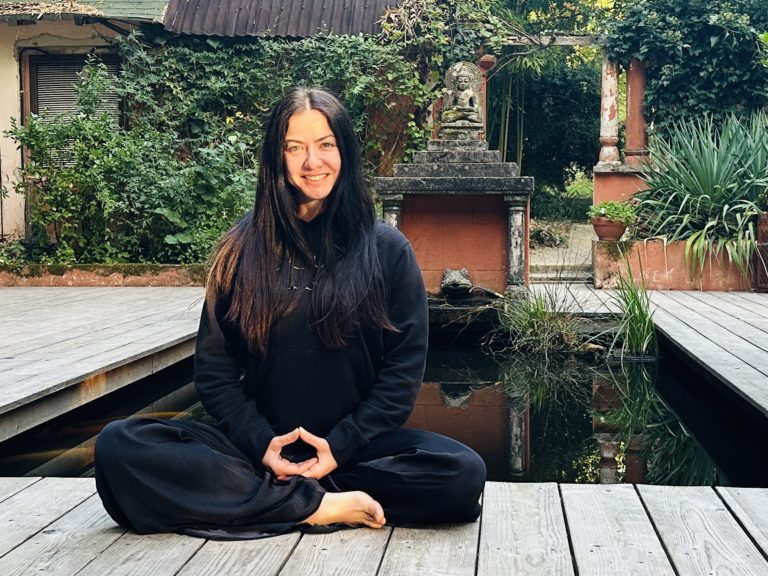Want to know how to prepare for a silent meditation retreat and what to expect?
What to expect on a silent meditation retreat will depend on where it’s being held and on the description of the retreat. One thing they all have in common however is that they’re held in complete silence! This is where knowing what to expect on retreat, and how to prepare for it helps, because once you’re there you can’t really ask any questions and more often than not you’re in the middle of nowhere. I’ve been on a few different types of silent meditation retreats, so here are my tips so that you know what to expect, and to make the experience even more enjoyable.
Firstly if you’re looking for peace and quiet, and an opportunity to get stuck into hours of meditation and introspection, a silent meditation retreat is just the thing. They are invariably in a location out in nature or at least in a very quiet village, or perhaps up a mountain. They are a wonderful opportunity for some deep introspection, peace, nature and healthy food.
One awkward thing is that you can usually talk to the other attendees on arrival day. You start to get to know people, and then after the initial group meeting or meditation where you are given all the information and an opportunity to ask questions, the silence begins. Sometimes its a bit strange because you were getting on quite well with someone, and then you walk past them all the time for a week, but can’t say a word! You can feel like you’ve shared a wonderful experience with others but you’re not allowed to talk about it and often have no idea what someone’s name is or where they live!

1.ACCOMMODATION
Bedrooms are usually very simple and some venues will not have private rooms or en-suite bathrooms on a silent meditation retreat. You will have a bed, bedside table,cupboard or draw space for your clothes and sometimes a desk. You may be asked to bring your own bed clothes and towels (especially if you are sleeping in an outside tent option) and bathrooms may be shared with members of the opposite sex. If there are single en-suite bedrooms they tend to get booked up very quickly, or you might go on a waiting list, and if they haven’t had enough bookings you may be allocated one closer to the time of the retreat.
2.CLOTHES
Pack warm clothes for a silent meditation retreat and most importantly some slippers and warm socks. You will not be able to wear shoes in the meditation hall and often in the buildings where you will be eating or sleeping. Thick socks are essential for keeping your feet warm, and they provide some padding for your ankles for long periods of sitting meditation. Good walking shoes are also important if there is the time and surroundings to go for a hike, and a swimming suit if there is a river or water source to swim in nearby.
Pack loose comfortable clothes and a shawl that you can easily put around you or take off during meditation. Usually you will walk outside from your room to the meditation hall very early in the morning, and if you’re like me your body temperature might rise during meditation. And if you are meditating outside then a shawl will help you from getting bitten by bugs. However you might get into trouble if seen wearing the shawl outside of meditation time as it should be one dedicated only for meditating.
3.WHAT ELSE TO PACK
Toothpaste, toiletries etc are not usually provided for you on a silent meditation retreat and some places will require all products to be eco friendly. Expect your butt and legs to go numb, and pins and needs in the feet from all the sitting. To help with this I have a foldable meditation bench that I travel with, and I’ve also seen people with memory foam cushions that look very comfortable. Make sure to take any supplements or medications you might need as you are unlikely to have a pharmacy nearby, and I recommend taking a self development type of book to read and a journal to write things that come up during the retreat.
4.KARMA DUTY
Karma duty or Seva is the act of selfless service and a tradition in the East when attending ashrams, courses and retreats. When you arrive for a silent meditation retreat there is either a sign up sheet where you can pick which duty you want to do, or sometimes it is allocated for you. Only a few places I’ve been to, like a Buddhist monastery, have not required a specific duty but you are always expected to have a tidy bedroom and meditation space, and tidy away or wash your dishes after meals.
Examples of karma duty are: picking herbs for the meals, chopping vegetables, cleaning the toilets, sweeping the floors, weeding the grounds, washing and drying after meals etc. Even on some of the more expensive silent meditation retreats I’ve been on I’ve had to put the sheets etc on my bed when I’ve arrived, and take them all off and clean my room on the day I leave. Try to arrive early on the first day to pick the more favourable karma duty. I try to avoid toilet duty if I can!

5.MEALS
More often than not a silent meditation retreat will follow Yogic or Buddhist principles which means they will serve vegetarian or vegan meals. If you’re lucky they may accommodate for certain allergies or intolerances, but not always. This is definitely worth checking beforehand if you are concerned. On some strict Buddhist retreats you may only get one meal a day, otherwise there are usually 2 or 3. You will not have access to the kitchen and will have to eat what is provided.
Expect porridge, almond milk, soy yogurt, fruit, or bread and jam for breakfast. Other meals will usually include some sort of carbohydrate, often rice, vegetables and salad. It might include a protein like beans, chickpeas or lentils, and at the more expensive retreats you may get tofu or tempeh. Some places may include a dessert otherwise there’s usually fruit. There is normally a tea station where you have access to teas all day, but if like me you like honey in your tea, bring your own as I’ve rarely seen it available.
TAKE SNACKS!
If the above sounds too sparse for you and like me you are a fussy eater with a sweet tooth, I highly advise taking some snacks! Apples and raisins don’t cut it for me, so I often take chocolate or biscuits. I don’t like spicy food or peppers which will invariably be on the menu at some point, and there’s no other option available. And if I’m concerned that there won’t be enough food then I sometimes take nuts, lentil crackers and Babybels. You’re likely to be in the middle of nowhere with no supermarkets or shops nearby so this is worth baring in mind.
You want to make sure that everything you take is in sealed bags so that you don’t attract mice, and if you have a favourite tea then pack that too. To be honest your body gets used to the new eating regime and if your retreat doesn’t include physical activity like yoga, then you’re not usually expending much energy anyway. When you’re sitting for hours meditating you don’t tend to get as hungry as in day-to-day life.

6.TIMETABLE AND MEDITATIONS
The timetable on a silent meditation retreat will vary between venues or retreat descriptions. There will be an early morning (before sunrise) meditation session of around an hour, before breakfast, and more often than not there will be an afternoon and an evening session too. Sometimes there will be a ‘teaching’ or ‘dharma lesson’ where the monk, nun, guru or teacher, will talk about an aspect of meditation or philosophy, that you will then meditate on. Some sessions can be 3 hours in one go. However if the sessions are more than 75 minutes, there will usually be a 10 minutes break to stretch the legs and go to the toilet.
Meditation sessions may also include some prayers, rituals or chanting. This tends to happen either at the beginning of each session or at the morning or evening ones. You will usually be taught the prayer or mantra or it will be on paper for you to read. Of course you can choose to stay silent during these if you are not comfortable participating.
In between meditation sessions there is time for walking meditations, reading or journaling, although some retreats don’t allow writing or reading as they are considered a distraction from the meditation experience. Usually there are some chairs around the meditation hall for those who struggle to sit on the floor for long periods of time, but there are usually plenty of cushions, bolsters, zabutons etc to make sitting on the floor more comfortable. The amount of meditation can vary from 4 to 8 hours a day, and a day will usually finish around 8.30pm – 10.30pm.
7.EMERGENCIES / ASKING QUESTIONS
On a silent meditation retreat that is less strict you will allowed you to whisper a question to a member of staff. Others will have clipboards or pieces of paper and pens where you can write questions and hand them to staff. Often there is a notice board where you can ‘post’ your question on paper, and check later to see if a reply with your name on it has be pinned to the board. There is often an office somewhere that will have specific office hours that you can use to either buy any essentials they have for sale or ask any questions.
EXTRA ADVICE
Tell work, family and friends that you are away on a silent retreat and not to contact you. The venue will often encourage you to hand in your phone and you can give family the venue’s number to call in an emergency. Without a phone you will need a watch and you’ll need an alarm clock to make sure you wake up on time in the morning. Sometimes an alarm will be provided for you, as well as slippers.
I hugely advise trying to slow down your life and mind for a couple of days before you arrive on retreat, otherwise you will arrive wired and stressed and it can take you a couple of days to find the physical and mental calm needed for long days of meditation. I also highly advise easing yourself back into normal life after and trying to delay going back to work for a couple of days after. I always make sure that I have noise cancelling headphones with me because I find the noise of traffic, people, even just quiet chatting extremely overwhelming after a silent meditation retreat. It’s a real insult to your senses and something to really bare in mind.
On the off chance that you’re looking for a retreat that is not so strict, where you are not in silence and there is less hours of meditation per day, feel free to check out my next long weekend retreat on Lake Schwarzsee in Switzerland. Like most non-silent retreats, we still practice mauna or noble silence in the morning before the first meditation or yoga session so that there is a peaceful and reflective energy to the start of the day. For a full on silent retreat the place I recommend the most is Moulin de Chaves run by Martin Aylward in France.
If you’ve been on a silent retreat I’d love to hear if your experiences have been different from mine or if you have any other advice for my readers.
xx






